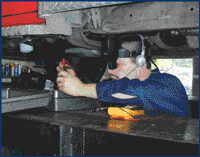Brent D. Johnson, Senior News Editor
Instant cameras, initially, were a boon to the auto repair industry, allowing mechanics who venture into unfamiliar territory to retrace their steps by reconstructing each phase of the assembly in color photos and reducing the incidence of spontaneous inorganic synthesis.
A display system from Microvision Inc. modernizes this concept. By projecting an image of the repair manual directly onto the retina, the Nomad Personal Display System allows a technician to compare the factory-specified configuration with a part, without turning away from the work.
Evan Miller, the lead mechanic for American Medical Response Ambulance, is responsible for keeping a fleet of Ford ambulances rolling. He saw a magazine article about the Microvision system being used in mapping, and he thought it might be useful for the repair business as well.

A technician at American Medical Reponse Ambulance wears the Nomad Personal Display System while working on one of the company's fleet of Ford ambulances.
In fact, in a recent field test of the Nomad system, he found that the device improved mechanics' efficiency by up to 70 percent. He also said that some of the less-experienced mechanics significantly improved their performance while using the display.
Miller explained that a mechanic first reads the system failure code from the vehicle's onboard computer, then puts on the Nomad headgear and simply speaks the code into a microphone that is attached to the headset. The computer then displays the stages of the related automotive system (brakes, engine, etc.). The mechanic scrolls through the stages by saying "next" to advance the screen or "back" to return to the former screen.
"I really thought it was excellent," Miller said. "You don't have to sit there and go through books."
The headgear places a small "screen" over one eye, but the wearer can flip it out of the way if necessary. The display "paints" the signal from an image source, such as the shop manual system, onto the retina with horizontal and vertical scanners and refractive and reflective optical elements. The resulting image gives the appearance of a full 19-in. screen held at arm's length.
Miller, who normally wears eyeglasses, was also impressed that he could see crisp lettering and images in red monochrome even without his glasses. Although he prefers to use the headgear without his glasses, he said there is enough room to wear them under it, if needed.
Although the headgear was a little bulky for working around the dashboard on the interior of the vehicles, Miller acknowledged, he thought the headband was comfortable. The company informed him that future models will have a slimmer profile.
American Medical Response worked with Microvision on alpha and beta tests of the system, and Miller said he hopes to have a permanent installation after Nomad's commercial release later this year.